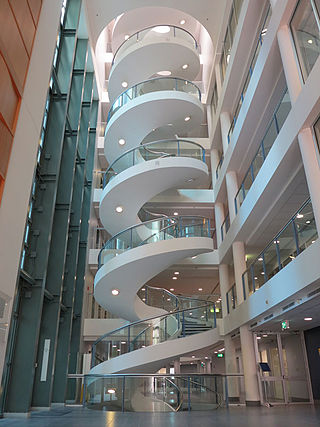Related Research Articles

The University of Technology Sydney (UTS) is a public research university located in Sydney, New South Wales, Australia. The university was founded in its current form in 1988, though its origins as a technical institution can be traced back to the 1870s. UTS is a founding member of the Australian Technology Network (ATN), and is a member of Universities Australia (UA) and the Worldwide Universities Network (WUN).

The Powerhouse Museum, formerly known as the Museum of Applied Arts & Sciences (MAAS), is a collection of museums in Sydney, and owned by the Government of New South Wales. Its main centre is in Ultimo, New South Wales, the others being the historic Sydney Observatory at Observatory Hill, and the newer Powerhouse Castle Hill at Castle Hill. Powerhouse Parramatta is due to open in 2025.
Bruce Bunji Kuwabara, is a Canadian architect and a founding partner of the firm KPMB Architects. He is an invested Officer of the Order of Canada and recipient of the RAIC Gold Medal. He is Board Chair of the Canadian Centre for Architecture in Montreal.
Hugh Francis Durrant-Whyte is a British-Australian engineer and academic. He is known for his pioneering work on probabilistic methods for robotics. The algorithms developed in his group since the early 1990s permit autonomous vehicles to deal with uncertainty and to localize themselves despite noisy sensor readings using simultaneous localization and mapping (SLAM).

Roderick George Robbie was a British-born Canadian architect and planner. He was known for his design of the Canadian Pavilion at Expo 67 and Toronto's Rogers Centre (SkyDome).

Carl Abraham Pihl was a Norwegian civil engineer and director of the Norwegian State Railways (NSB) from 1865 until his death. Pihl was one of the main architects of the use of narrow-gauge railways in Norway.

The Institution of Structural Engineers' Structural Awards have been awarded for the structural design of buildings and infrastructure since 1968. The awards were re-organised in 2006 to include ten categories and the Supreme Award for structural engineering excellence, the highest award a structural project can win.

The Faculty of Engineering is a faculty of the University of Sydney, Australia. It was established in 1920 and is one of the oldest engineering schools in Australia.

Kenneth Frank Charles Woolley, BArch, Hon DSc Arch Sydney LFRAIA, FTSE, was an Australian architect. In a career spanning 60 years, he is best known for his contributions to project housing with Pettit and Sevitt, four time Wilkinson Award-winning architect, including three times for his own house, the first being the 1962 Woolley House in Mosman, and his longstanding partnership with Sydney Ancher and Bryce Mortlock. He is regarded as being a prominent figure in the development of the Sydney School movement and Australian vernacular building.
Cundall is a multi-disciplinary engineering consultancy. Originally based in Newcastle and Edinburgh, the company had spread its operations across five continents.
Graham Leon Collingridge is a British neuroscientist and professor at the University of Toronto and at the University of Bristol. He is also a senior investigator at the Lunenfeld-Tanenbaum Research Institute, Mount Sinai Hospital in Toronto.
Jonathan Lomas is a British-Canadian health researcher and the inaugural chief executive officer of the Canadian Health Services Research Foundation (CHSRF). He specializes in health services research and knowledge translation/exchange and has been called the "godfather of knowledge translation" by the Canadian Institutes for Health Research. Lomas became an Officer of the Order of Canada in 2010.

The Canada West Foundation is a conservative non-partisan think tank based in Calgary, Alberta. It researches issues of concern in British Columbia, Alberta, Saskatchewan, and Manitoba and issues of national significance.

1243 is a preserved former New South Wales Government Railways Z12 class steam locomotive. Built in 1882 by Atlas Engineering Company, Sydney, it is on static display at the Powerhouse Museum.
Joseph H. Hulse (1923–2013) was a Canadian biochemist, food technologist, writer, and the president of the International Union of Food Science and Technology. He chaired the Committee of the Canadian chapter of the Freedom From Hunger, presided over the Canadian Institute of Food Science and Technology and was the assistant director of nutrition at the Food and Agriculture Organization, besides serving as the vice president of the International Development Research Centre (IDRC). He was the author of several texts and monographs on nutrition and allied sciences, including a 991-page treatise, Sorghum and the Millets: Their Composition and Nutritive Value. The Government of India awarded him the fourth highest civilian honour of the Padma Shri, in 2008, for his contributions to Science and for his humanitarian activities in India.
Lisa Havilah is the CEO of the Museum of Applied Arts and Sciences (MAAS) in Sydney, Australia. She has previously directed various arts centres in Sydney, including Carriageworks and Campbelltown Arts Centre.
Eric M. Meslin PhD is a Canadian-American philosopher-bioethicist and current President and CEO of the Council of Canadian Academies (CCA).
John Buxton Laurie was an Australian consultant engineer. In 2003 he was awarded Australia's highest civilian honour, Companion of the Order of Australia, for his services to engineering and to community support.
Deo Prasad AO FTSE is an Australian academic in the fields of environment, sustainability and governance, with a focus on decarbonisation, clean energy and energy efficiency. Prasad was appointed an Officer of the Order of Australia in 2014. He is a Fellow of the Australian Academy of Technological Sciences and Engineering and a Fellow of the Royal Australian Institute of Architects.
References
- ↑ Wade Chambers and Rachel Faggetter, "Australia's Museum Powerhouse", Technology and Culture , Vol. 33, No. 3 (July, 1992), pp. 548–559.
- ↑ Toronto IdeasCity Presenter Lindsay Sharp, 2002.
- ↑ Royal Academy of Engineering Award for the Man behind the Science Museum Archived 5 July 2014 at the Wayback Machine , Royal Academy of Engineering, 2 June 2005.
- ↑ Mark Henderson, Science Museum II thinks big to liberate locked-away gems [ dead link ], The Times , 16 June 2007.